Category: News
Government Returns Confiscated Eagle Feathers to Tribal Leader, Still Enforces Arbitrary Law
Story by the Fairfield Sun Times
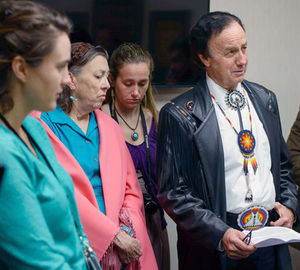
courtesy photo
Washington, D.C. – Today the federal government returned the property it had seized from a Native American man exactly nine years ago: his eagle feathers. (see video)
Although just moments ago Mr. Robert Soto, a Lipan Apache religious leader and renowned feather dancer, received the tribe’s sacred feathers, the federal government has not repealed an arbitrary federal law forbidding Mr. Soto and others like him from possessing eagle feathers, and it is still threatening Mr. Soto with punishment for practicing his faith. The Becket Fund continues to defend Mr. Soto in court, and today it will be filing a motion to obtain protection from this unjust law.
“The government has about a million better things to do with taxpayer money than send undercover agents to raid Native American powwows and confiscate their eagle feathers, ” said Luke Goodrich, Deputy General Counsel for the Becket Fund for Religious Liberty.
In 2006, the government sent undercover agents to a Native American religious ceremony called a powwow to confiscate eagle feathers, which play a central role in the Native American faith. The agent was enforcing federal laws that prohibit possession of eagle feathers without a permit. The laws grant permits to museums, scientists, zoos, farmers, and “other interests, ” such as large power companies. They also grant permits to Native Americans who are members of “federally recognized” tribes. But they don’t grant permits to Mr. Soto’s tribe–the Lipan Apache Tribe of Texas. Although the Lipan Apache are recognized by historians, sociologists, and the State of Texas, they are not recognized by the federal government.
Mr. Soto challenged this arbitrary treatment under the Religious Freedom Restoration Act–the same law that featured in last year’s Supreme Court decision involving Hobby Lobby. In August 2014, the United States Court of Appeals for the Fifth Circuit ruled in his favor.
Although the Government has returned Mr. Soto’s feathers, it persists in threatening Mr. Soto and his congregation with civil and criminal penalties if they use eagle feathers in their religious services.
“The government allows hundreds of eagles, if not thousands, to be killed every year for non-religious reasons. Yet it won’t allow these Native Americans to possess even a single feather. ” said Goodrich. “It’s time to let Native Americans practice their faith; we’re not living in the 1800s anymore. ”
The Becket Fund for Religious Liberty is co-counsel in the case, together with the international law firm of Baker Botts LLP, and the Civil Rights Legal Defense and Educational Fund.
Connecticut Tribes Band Together In New Push For Expanded Gambling
By Kevin Horridge, www.casino.org

Expanded gambling in Connecticut was supposed to be dead a month ago. But the proposal seems more alive than ever, as both Mohegan Sun and Foxwoods have been lobbying hard to get the state legislature to at least consider the measure as a way to combat the new casinos that are being built in neighboring Massachusetts.
It’s unclear what the Mohegans and Mashantucket Pequots, the two tribes that operate the Native American casinos in Connecticut, would ask for or be able to get from state lawmakers.
It could be something as extensive as a brand new casino in northern part of the state that would attempt to convince state residents not to travel to Massachusetts once casinos are built there, or it could be a more modest proposal to add slot machines to off-track betting locations.
Officials, Lawmakers Speak Vaguely of Gambling Expansion
“We’re talking about ways to preserve jobs,” said Mashantucket Pequot chairman Rodney Butler, though he did not specify exactly what he or the tribe were planning. Butler and Mohegan Tribal Gaming Authority chairman Kevin Brown traveled together last Wednesday to meet with Democratic leaders in Connecticut’s Senate.
“I view them as a major employer in our state,” said Senate Majority Leader Bob Duff (D-Norwalk), who a month ago declared their efforts dead but admitted to meeting with the tribal leaders last week. Like others, Duff provided few details on exactly what anyone was proposing.
Despite the lack of concrete proposals being floated publically, there are signs that at least some officials plan to help the tribes battle against increasing competition in the region.
“The gaming industry never goes away,” said State Representative Stephen Dargan (D-West Haven), who says the Public Safety and Security Committee that he chairs is likely to approve some kind of gambling expansion bill by a March 19 deadline. “It’s always an interesting topic.”
The sudden increase in chatter around the casino industry comes after last Wednesday’s release of the Northeastern Casino Gaming Research Project’s latest update. According to the group’s most recent report, Foxwoods and Mohegan Sun has seen both their revenues and their employment rolls shrink by more than 35 percent since 2006, when the casinos were at their peaks. The combined revenue for the two casinos was just $1.9 billion last year, down from $3.2 billion in 2006.
Governor Acknowledges Issue, But Isn’t Taking Sides
Even Governor Dannel Malloy was willing to talk about the possibility of expanded gambling in his state, though he was careful not to take a position on the issue.
“This is not my proposal,” Malloy said to reporters while at the Mohegan Sun casino. “Other people are making it. I’m not saying no, I’m not saying yet.”
Malloy also acknowledged that the tribes are likely to need to do something once the MGM Springfield casino opens, which is expected to happen in 2017.
“Whether it’s nuclear or not, obviously gaming is becoming ubiquitous,” Malloy said. “And so when you have a state on your northern border that is going to have at least six establishments, that’s an issue. When Rhode Island improves their facilities, that’s an issue. I think the tribal nations have said, ‘Hey, we think this is a way to handle that.’”
Swinomish Tribe’s Restoration Improves Fish Passage Beside Farmland
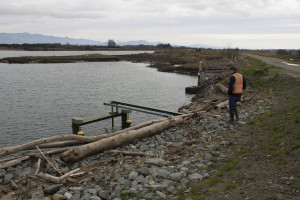
By Northwest Indian Fisheries Commission
Farming interests in Skagit County often seem at odds with salmon habitat restoration, but an ongoing project by the Swinomish Tribe aims to show that it doesn’t have to be that way.
The tribe owns the land known as the Smokehouse tidelands along the Swinomish Channel south of the Swinomish Casino and Lodge. Historically, the land was part of a system of channels that served as estuarine rearing habitat for Skagit River salmon. When the Skagit Valley was settled, the tidelands were diked and drained for agricultural use.
Since 2005, the tribe has restored tidal flow and improved fish passage to the channels by replacing four traditional flap gates with self-regulating tide gates. In addition, three culverts have been replaced by bridges, and several have been removed.
“The big advantage is for fish, but the tide gates also have improved drainage capacity,” said Todd Mitchell, Swinomish environmental director. “As more water comes in, more water goes out. We don’t have the ponds of standing water that you see on other farmland after heavy rain.”
Fifty-foot buffers have been planted between the channels and the farmland. Some of the land will remain in agricultural use, with the tribe leasing it to farmers and monitoring for saltwater intrusion.
“Continued farming provides income for the Swinomish Tribe,” said Steve Hinton, restoration director for the Skagit River System Cooperative, the natural resources extension of the Swinomish and Sauk-Suiattle tribes. “The goal is to see that agriculture and salmon can not only survive, but thrive in the same space.”
The long-term plan is for riparian corridors, tidally connected channels and estuarine wetlands to exist alongside agricultural production.
“Resolving the differences between these competing uses of the resource are essential to significant and meaningful restoration of chinook rearing habitat across the Skagit delta,” Hinton said.
Action Taken To Protect Fish At Bottom Of Ocean Food Chain
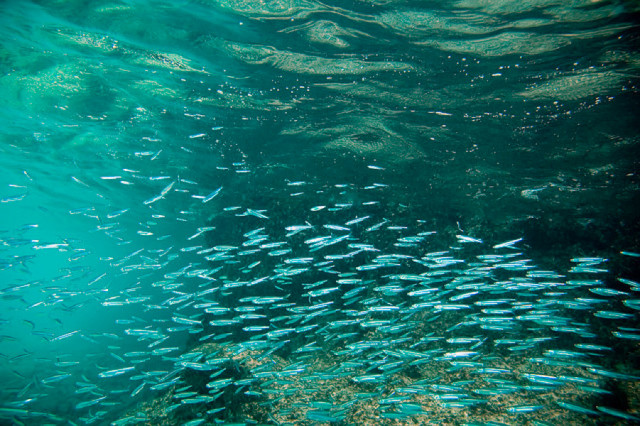
Paul Asman and Jill Lenoble/Flickr
by Cassandra Profita OPB
West Coast fishery managers adopted a new rule Tuesday that protects many species of forage fish at the bottom of the ocean food chain.
The rule prohibits commercial fishing of herring, smelt, squid and other small fish that aren’t currently targeted by fishermen. It sets up new, more protective regulations for anyone who might want to start fishing for those species in the future.
The Pacific Fishery Management Council unanimously voted to adopt the rule at a meeting in Vancouver, Washington. The council sets ocean fishing seasons off the coasts of Washington, Oregon and California.
The idea behind the new rule is to preserve so-called forage fish so they’re available for the bigger fish, birds and whales that prey on them. It’s part of a larger push by the council to examine the entire ocean ecosystem when setting fishing seasons.
Environmentalists who have been advocating for the rule for years celebrated the approval.
“If we’re going to have a healthy ocean ecosystem in the long term, we have to protect that forage base,” said Ben Enticknap of the environmental group Oceana. “These are the backbone of a healthy ocean ecosystem.”
Enticknap said many of the forage fish subject to the new rule are already being fished elsewhere in the world. Little fish at the bottom of the food chain are used to make fish meal for aquaculture, and they’re increasingly in demand as food for people as other fish populations decline.
Previous rules only required managers to be notified of a new fishery on non-managed forage fish species. Now, the council will require a more rigorous scientific review to prove that the new fishery won’t harm the ecosystem before it is allowed.
“Really, it’s being precautionary,” said Enticknap. “It’s getting out ahead of a crisis rather than waiting for a stock to collapse and then having to have serious consequences for fisheries after the fact.”
The rule has gained broad support — even from the fishing industry, according to Steve Marx of the Pew Charitable Trusts. Valuable commercial fish such as rockfish, salmon, halibut and tuna all prey on forage fish.
“The fishing industry support has been pretty strong because everybody understands how important these small forage fish are to the fish they like, that they make a living off of,” he said.
Rod Moore, executive director of the West Coast Seafood Processors Association, congratulated the council on moving forward with the rule.
“It’s rare to get this sort of consensus support from commercial, environmental and recreational sectors, and I think you have it on this one,” he said.
Before voting, council members discussed the best way to allow existing fisheries to catch some of the forage fish species incidentally – as they’re targeting other fish.
The council directed staff to continue developing the details of the rule so that it doesn’t constrain existing fisheries, but it does discourage fishing boats from targeting forage fish.
Councilors instructed staff to hold fishing boats accountable the forage fish they catch and consider discouraging development of at-sea processing of forage fish species into fish meal.
Wyoming Lawmakers Approve Spending For Northwest Coal Ports

Cassandra Profita/OPB
By: Earthfix; source OPB
Wyoming lawmakers have passed legislation that would allow the state to finance the construction of coal export terminals in the Pacific Northwest and elsewhere.
On Friday, Wyoming’s state legislature sent to Gov. Matt Mead a bill that would allow the state to issue up to $1 billion in bonds to help fund out-of-state projects, including coal export terminals.
Lloyd Drain, director of the Wyoming Infrastructure Authority, said these projects would be good for Wyoming coal and the Northwest, too.
“If I’m looking at it with my Washington state or Oregon state hat on, I think there’s a lot more benefits to be had than any risk,” he said. Wyoming plans to send a delegation to Pacific Northwest later this spring to lobby Native American tribes for support.
The Legislature’s vote is the latest in a series of steps by Wyoming politicians to push for the construction of export terminals hundreds of miles away on the West Coast. Last June Wyoming’s governor made a publicized trip to Washington to raise awareness of his state’s interest in moving its coal through the Northwest. Then in October, Mead invited tribes and city and county leaders from the Northwest to visit Wyoming to see the benefits of supporting the export of Wyoming coal coal through their states.
- Related: Coal in the Northwest — a guide to proposed export terminals
Coal export projects are proposed on Puget Sound near Bellingham, Washington, and on the Columbia River in Longview, Washington. A third, smaller terminal on the Oregon side of the Columbia was rejected last August by state regulators. That decision is being appealed.
The projects have had trouble with financing. In late 2014 Ambre Energy sold its interest in terminals in Oregon and Washington to a private equity firm in order to remain solvent.
This was first reported by Inside Energy, a reporting team based in energy boom states.
Statue of Chief Joseph Recommended for U.S. Capitol
A state commission has recommended to legislators that statues of two pre-statehood figures representing Oregon in the U.S. Capitol’s National Statuary Hall be replaced by statues of Nez Perce leader Chief Joseph and women’s rights advocate Abigail Scott Duniway.
If approved by Oregon’s legislature, Chief Joseph’s statue would be the eighth of an indigenous figure in the National Statuary Hall. The others:
Sequoyah (c. 1770-1840), creator of the Cherokee syllabary; given by Oklahoma in 1917.
William Penn Adair “Will” Rogers, Cherokee (1879-1935), entertainer and social commentator; given by Oklahoma in 1939.
Kamehameha I, king of Hawaii (1758-1819); given by Hawaii in 1969.
Chief Washakie (c. 1798-1900), Eastern Shoshone leader; given by Wyoming in 2000.
Sacagawea, Lemhi Shoshone (c. 1788-1812), guide and interpreter for the Lewis and Clark Expedition; given by North Dakota in 2003.
Sarah Winnemucca, Paiute (1844-1891), educator, author, and defender of her people’s rights; given by Nevada in 2005.
Po’pay, Tewa (c. 1630-c. 1688), leader of the 1680 Pueblo Revolt against Spanish colonial rule; given by New Mexico in 2005.
Sequoyah’s statue was the first representing a Native American to be placed in Statuary Hall. Kamehameha’s statue, at 9 feet 10 inches tall on a 3-foot-6-inch granite base, is the largest and heaviest in Statuary Hall. The statue of Po’pay is the first in Statuary Hall by a Native American artist, Cliff Fragua, Jemez Pueblo. Gov. John Kitzhaber, Dr. John McLoughlin, Rev. Jason Lee,
Since 2003, seven states have replaced statues with those representing figures they feel better represent their history or contributions to humankind. In August 2014, then-Oregon Gov. John Kitzhaber established the Statuary Hall Study Commission to determine whether Oregon’s statues of pre-statehood leaders Dr. John McLoughlin (1784-1857) and Rev. Jason Lee (1803-1845) should remain or be replaced by other notable Oregonians.
Commission chairman Jerry Hudson notified Kitzhaber and legislative leaders on January 26 that the commission had unanimously agreed to recommend the statues of McLoughlin, the Hudson’s Bay Company’s superintendent at Fort Vancouver, and Lee, missionary and founder of Willamette University, be returned to “places of honor” in Oregon and that “two equally worthy individuals who represent different chapters in Oregon’s history” be installed in National Statuary Hall, according to the commission’s website.
On March 4, the commission made the recommendation formal with a vote. According to KGW.com, Chief Joseph received seven votes from the nine-member commission, Duniway received six.
Jim Boyd is chairman of the Confederate Tribes of the Colville Reservation, where descendants of Chief Joseph’s Wallowa band are enrolled today.
“The statue of Chief Joseph at Statuary Hall in D.C. will be a great honor to Chief Joseph and to all those who have been left a legacy that has helped mold who we are today as very proud Indian people,” Boyd said.
“He stood strong and fought hard for his people and territory in a way that will always be remembered, and will continue to inspire and guide what will be for generations to come. It is a great thing that the state of Oregon is initiating this legislation.”
According to a state biography, Chief Joseph, or Heinmot Tooyalakekt (Thunder Rising to Loftier Mountain Heights), was born in 1840 in the Wallowa Valley of eastern Oregon. His father, Tuekakas, was the leader of the largest of independent Nimiipuu, or Nez Perce, bands living in Oregon, central Idaho, and southeastern Washington. Heinmot Tooyalakekt became leader in 1871 upon his father’s death.
Heinmot Tooyalakekt’s band never agreed to an 1863 treaty that surrendered 90 percent of Nimiipuu lands, and resisted the federal government’s order to abandon their ancestral lands and move onto a small reservation.
According to the biography: “In meetings and councils from 1874 to 1877 with army officers, Indian agents, and a delegation from Washington, D.C., [Heinmot Tooyalakekt] argued persistently that the resistant Nez Perce bands were not bound by the 1863 treaty. As a follower of the Dreamer religion of the Columbia Plateau, he pleaded as well that his people were intimately bound to their homeland and could never leave it, and that to become farmers, as the government insisted, would violate the Earth Mother.”
In spring 1877, Gen. Oliver O. Howard, commander of U.S. forces in the Pacific Northwest, insisted that all resisting bands report to the reservation within a month. (According to another bio, this forced removal violated the 1855 Treaty of Walla Walla, in which the Nez Perce reserved 7.5 million acres of their ancestral lands and the right to hunt and fish in their usual and accustomed territory.) Howard’s order resulted in the Nez Perce War of June to October 1877.
Heinmot Tooyalakekt and other Nimiipuu were captured 40 miles from the U.S.-Canada border. It was here, at the base of the Bear’s Paw Mountains near present-day Chinook, Montana, that Heinmot Tooyalakekt made his brief speech of surrender that reportedly ended with, “From where the sun now stands I will fight no more forever.”
According to the state’s biography, Heinmot Tooyalakekt “was never a war leader. He was, rather, a diplomat and a negotiator, and he made his greatest contribution in that role after the war.” The U.S. exiled the Nimiipuu to Indian Territory, present-day Oklahoma. For eight years, Heinmot Tooyalakekt campaigned for his people’s return to the Pacific Northwest. He spoke with the press, politicians and President Rutherford B. Hayes about the injustices committed against his people.
Finally, in 1885, the Nimiipuu were allowed to return to reservations in Idaho and Washington, but not to eastern Oregon. Heinmot Tooyalakekt visited, but never again lived in, the Wallowa Valley.
Heinmot Tooyalakekt, Chief Joseph, died in his home on the Colville Reservation on September 21, 1904. His grave, marked by a large monument, is in Nespelem on the reservation.
First statue placed in 1870
According to the Architect of the U.S. Capitol: National Statuary Hall, located south of the Rotunda, was the meeting place of the U.S. House of Representatives from 1807 to 1857.
In 1864, in accordance with legislation sponsored by Rep. Justin Morrill of Vermont, Congress invited each state to contribute two statues of prominent citizens for permanent display in the room, which was renamed National Statuary Hall. The first statue was placed in 1870.
“Today, National Statuary Hall is one of the most popular rooms in the U.S. Capitol Building,” according to the Architect’s website, “It is visited by thousands of tourists each day and continues to be used for ceremonial occasions. Special events held in the room include activities honoring foreign dignitaries and presidential luncheons.”
Read more at http://indiancountrytodaymedianetwork.com/2015/03/07/statue-chief-joseph-recommended-us-capitol-159499
Northwest Residents, With Wood To Burn, Among Top Polluters
KEITH RIDLER, Associated Press
BOISE, Idaho (AP) — Oregon, Idaho, and Washington residents are among the top polluters in the nation when it comes to fine particle emissions from burning wood to heat homes.
The U.S. Environmental Protection Agency lists Oregon, Idaho and Washington as seventh, eighth and ninth respectively in per capita emissions.
The three states share chilly climates, a tradition of wood burning, and lots of national forest land with easy access and where U.S. Forest Service managers appreciate the removing of some trees to reduce potential forest fires.
“We have a very large fuel wood cutting program and a large public that takes advantage of it,” said Julie Thomas, spokeswoman for the Sawtooth National Forest in Idaho. “For a lot of folks, it helps them reduce the cost of purchasing heat in the wintertime.”
Wood burning is also popular in Oregon, where that state’s Department of Environmental Quality found that a third of residents in the densely populated Portland region burn wood.
Marcia Danab, an agency spokeswoman, said southeast Portland as well as some other areas of the state that experience inversions have problems with wood smoke. Health agencies issue alerts when it’s unhealthy to be outside.
To alleviate the problem the state, she said, in 2009 enacted a law requiring uncertified woodstoves to be removed and destroyed when a home is sold.
“The newer stoves that conform to EPA standards put out far less particulates,” Danab said.
That’s the kind that a Washington state company called Rich’s For The Home sells at its five store locations in that state.
Beth Urban, an assistant manager at the company’s Lynnwood store, said the state has some of the strictest standards for wood stove emissions. To meet those standards, the new stoves use what Urban called secondary reburns that eliminate many of the particles.
She also said the stoves, while more expensive, in the long run save money because they’re more efficient, some models using half the wood to produce the same amount of heat as older stoves.
The stoves come in various materials, with soapstone being the most expensive. Urban said prices range from $3,000 to $4,000 for a soapstone stove, but they are also among the most attractive and effective at distributing heat.
“It cuts your consumption down quite a bit,” she said. “The newer wood stoves, you can load up the fire boxes to last six, eight, sometimes 10 hours. Nobody likes to babysit a wood stove.”
Washington Tribe’s Whale Hunt Proposal Gets First Look From Regulators
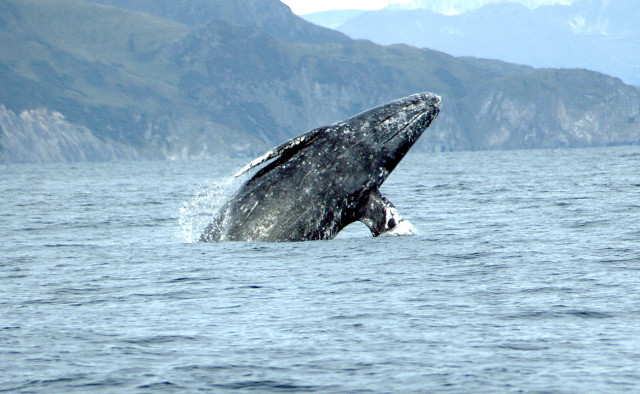
Courtesey of NOAA
by David Steves OPB
Washington’s Makah Indian tribe wants to resume its traditional practice of whale hunting.
The first step in winning federal approval came Friday, when NOAA Fisheries issued a draft environmental impact statement analyzing the tribe’s request.
The Makah tribe drew international criticism from animal rights groups in 1999 when it hunted a gray whale off Washington’s Olympic Peninsula. It was the tribe’s first whale hunt in more than 70 years.
The Makah have cited the ceremonial and subsistence nature of whale hunting, which it negotiated as a right preserved under its 1855 treaty with the U.S. government.
On their website the Makah tribe says whaling and whales are central to their culture.
“The event of a whale hunt requires rituals and ceremonies which are deeply spiritual. Makah whaling (is) the subject and inspiration of Tribal songs, dances, designs, and basketry.” the tribe says. “For the Makah Tribe, whale hunting provides a purpose and a discipline which benefits their entire community.”
The Makah are seeking to hunt gray whales from the eastern North Pacific stock, which is fully recovered from the impact of historic whaling in the Pacific. The gray whale was removed from the list of threatened and endangered species in 1994. The eastern North Pacific population is estimated to number about 20,000 whales.
NOAA Fisheries has proposed several options. One would allow the tribe to take up to five whales per year. Another would continue a prohibition against hunting gray whales.
“This is the first step in a public process of considering this request that could eventually lead to authorization for the tribe to hunt gray whales,” said Donna Darm, associate deputy regional administrator for NOAA Fisheries’ West Coast Region. “This is the public’s opportunity to look at the alternatives we’ve developed, and let us know if we have fully and completely analyzed the impacts.”
The draft analysis and additional information is available online. The public can submit comments over the next 90 days.
What a Record-Low Snowpack Means For Summer In The Northwest
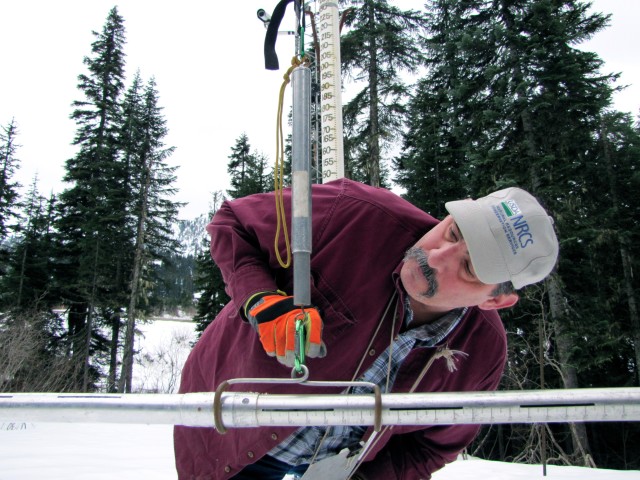
Ashley Ahearn/KUOW
by Ashley Ahearn KUOW
Scott Pattee stands well over 6 feet, but he’s dwarfed by the tall white tube set up near the Stevens Pass Ski Area to measure snow depth.
Little black numbers marking inches of snow ascend the side of the tube. The top number reads 250 inches, an amount of snow that’s hard to imagine right now.
Most of the mountains around Pattee are green and brown, not white – even though it’s officially still winter until March 19 arrives.
And the snow depth, according to the tower?
“We have about 30 inches,” said Pattee, a water supply specialist with the Natural Resources Conservation Service. “Normally we would have closer to 150 this time of year. It’s not good.”
Actually, it’s really bad. Record-breaking bad.
Pattee has been monitoring snow levels in Washington for more than 20 years. The data he gathers helps scientist study climate trends, farmers plan their growing seasons, hydropower operators manage their reservoirs and municipalities provide water to citizens.
This year is on track to be one of the lowest snow years on record. Across Washington state, average snowpack is 71 percent below normal levels. In some places, including the Olympic Peninsula, snowpack is 90 percent below normal levels.
Things are looking even worse in Oregon. Statewide, average snowpack is 76 percent below normal levels.
“One of our longest-monitored sites, near Bend, has the lowest snowpack ever recorded, breaking the 1977 record,” said Julie Koeberle, a hydrologist in Oregon with the Natural Resources Conservation Service. The Bend site has been monitored since the early 1950s.
“All eyes will be pointing on southern and southeastern Oregon if things don’t improve,” Koeberle said. Some of the lowest snow levels can be found in those areas, where water scarcity has created drought conditions in recent years.
However, despite dire warnings about low snowpack, things aren’t looking desperate, yet on all fronts. That’s because the Northwest is seeing normal or above-average amounts of overall precipitation, it’s just coming as rain instead of snow.
“The snowpack is bad but the overall conditions aren’t that horrible. It’s above normal precipitation all over the state, and so we’re in pretty good shape there for now,” Pattee said, adding that the region could see drought later in the summer.
The Bonneville Power Administration manages 31 federal dams on the Snake and Columbia rivers and provides one-third of the electricity consumed in the Northwest. Mike Hanson, spokesman for BPA, said things are looking normal.
“We’re doing just fine at the moment,” Hanson said, adding that the reservoirs above the dams are at normal levels. The Columbia River’s headwaters are in the Canadian Rockies, which are seeing normal snow levels this year.
“When we’re looking out our windows here and it seems very little snow, mild winter, conditions up at ski resorts are horrible, but that’s not really an indication of the total picture,” Hanson said. “Right now it looks like all systems are running normally and we are closely watching what is happening out there. We feel OK with where we’re at.”
The City of Seattle gets its water supply from the Tolt and Cedar rivers east of the city. Reservoirs managed by Seattle Public Utilities are currently above normal, and it plans to keep them full, even as it anticipates a warm dry spring with little additional rainfall.
“We don’t need snow to have a good water supply as long as it rains, which it has been,” said James Rufo-Hill, meteorologist and climate adaptation specialist with Seattle Public Utilities. “We’ll hold a little more water in our reservoirs and constantly manage that flow. We can meet demands throughout the summer.”
Resource managers, hydropower operators and others have referred to the snow levels and warm temperatures this year as “anomalous.” Amy Snover, director of the Climate Impacts Group at the University of Washington, agrees, but she said it’s an anomaly worth noting.
“It’s a really useful year in the sense that this is the kind of year that all the climate models tell us to expect,” Snover said. “The future looks like this. The future looks like less snow because of warmer temperatures but not necessarily less precipitation.”
Snover said water managers and hydropower operators need to be nimble.
“In many cases, the water managers who are paying attention to conditions can change the way they manage their systems and catch that water as it’s going down the river because it fell as rain instead of snow,” she said.
But for other basins or municipalities that are heavily reliant on surface water, without reservoirs to store it, the lack of snow this year presents a challenge. Places like Sequim and Port Townsend on Washington’s Olympic Peninsula are heavily reliant on rivers that are largely fed by snowpack from the Olympic Mountains, which are at record-setting low snow levels.
In drier parts of the region, meeting irrigation demands for agriculture could also prove challenging later on in the summer and early fall.
Pattee with the Natural Resources Conservation Service also cautioned that the wet, warm spring has started an early growing season, which could provide more fuel for wildfires later on in the dry season. For now he said the biggest impacts of low snow levels this year will be felt by recreationists and fish.
Without the strong pulse of cold snow melt, some Northwestern rivers could prove less hospitable to spawning salmon and their out-migrating young, Pattee said.
Regional water managers will brief Washington Gov. Jay Inslee on the snow situation early next week. Pattee said it’s too early to say if a drought declaration is in order but it is a concern.
“We’re going to have to sleep with one eye open this spring and summer and really keep a close eye on conditions and see which way the wind blows,” he said.










